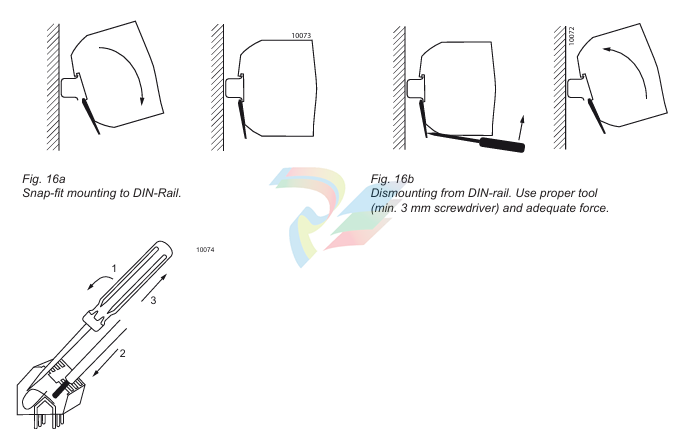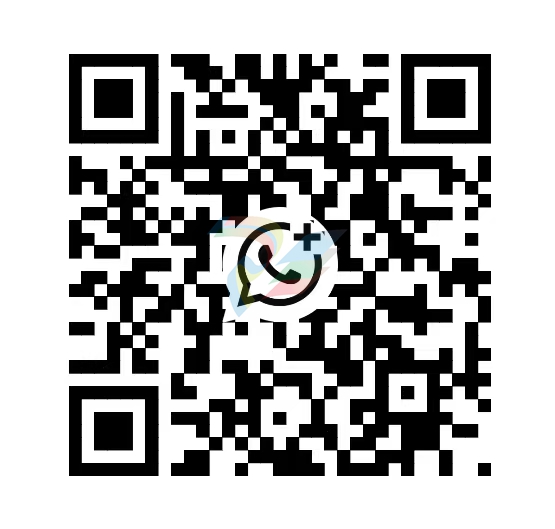Melcher W Series 125, 250 Watt AC-DC and DC-DC DIN-Rail Converters Convert Select LWN2660-6E-G
Installation Instructions
The converters of the W Series are components, intended exclusively for inclusion within other equipment by professional installers. Installation must strictly follow the national safety regulations in compliance with the enclosure, mounting, creepage, clearance, casualty, markings and segregation requirements of the end-use application.
DIN-rail mounting is possible with the built-in snap-fit device on a DIN-rail. This fulfills the mechanical transport re quirements as per ETSI 300019-1-2, class 2 (vertical). To fulfill the requirements of IEC 721-3-2, class 2.1 (vertical), 2 additional fixing brackets HZZ00624-G (see Accessories) must be fitted on the bottom side of the DIN-rail. For heavy duty railway applications, we recommend installing all 4 fixing brackets HZZ00624-G.
Chassis or wall mounting is possible using the universal chassis-mounting brackets HZZ00618-G (see Accessories). Such installa tion complies with IEC 721-3-2, class 2.2 (vertical and horizontal).
Caution: Install the converters vertically, and make sure that there is sufficient airflow available for convection cooling. The minimum space to the next device should be: top/bottom: 30 mm, left/right: 20 mm.
The converters of the W Series are class I equipment: Input terminal 1 ( ) and the output terminals 1 and 11 ( connected to the case. For safety reasons it is essential to connect the input terminal 1 ( ) are reliably ) with protective earth. Output terminals 1 and 11 can be used to connect the output voltage(s) or the load to functional earth.

The phase input (L or Vi+) is internally fused; see Input Fuse. This fuse is de signed to break an overcurrent in case of a malfunction of the converter and is not customer-accessible. External fuses in the wiring to one or both input lines (L and/or N ) may be necessary to ensure compliance with local requirements. A built-in second fuse in the neutral path is available as option F. A second fuse in the wiring to the neutral terminal N or option F is needed if:
• Local requirements demand an individual fuse in each source line
• Neutral and earth impedance is high or undefined
• Phase and neutral of the mains are not defined or cannot be assigned to the corresponding terminals (L Models with Option F: Caution! Double-pole/neutral fusing. to phase and N to neutral). If the converters operate at source voltages above 250 VDC, an external fuse or a circuit breaker at system level should be installed. Caution:
• Installation must strictly follow the national safety regulations.
• Do not open this apparatus
Standards and Approvals The converters of the LW Series with feature E were safety-approved to IEC/EN 62368-1 3rd edition and UL/CSA 60950-1 2nd edition (models without E: IEC/EN 62368-1 3rd edition), IEC 61010-1:C11:2002 (models without E: IEC 61010-1), and EN 50178:1997 (with and without E). The converters are UL508-listed components. The EW models are safety-approved to IEC/EN 62368-1 3rd edition and UL/CSA 60950-1 2nd edition The converters have been designed in accordance with said standards for:
• Class I equipment
• Power supply for building-in, vertical mounting on 35 mm DIN-rail or on a wall
• Overvoltage category II (III for 110 VAC supply)
• Basic insulation between input and case, based on 250 VAC
• Double or reinforced insulation between input and output, based on 250 VAC and 350 VDC.
• Functional insulation between outputs and case.
• Functional insulation between outputs.
• Pollution degree 2 environment. The converters are subject to manufacturing surveillance in accordance with the above mentioned standards and with ISO9001:2015. Operation at Frequencies Greater 60 Hz The LW Series converters have been tested for operation up to 440 Hz. However, the Y and X caps are not approved to such frequency. The leakage currents are higher than at 60 Hz, whereas the output ripple voltage is lower. Leakage Currents with AC Supply Leakage currents flow due to internal leakage capacitance and RFI suppression Y-capacitors. The current values are proportional to the mains voltage and nearly proportional to the mains frequency. They are specified at maximum operating input voltage where phase, neutral, and protective earth are correctly connected as required for class I equipment. Leakage current may exceed 5 mA, if f i > 63 Hz. Railway Applications The W Series converters have been designed observing the railway standards EN 50155 and EN 50121. All boards are coated with a protective lacquer. The EW Series is particularly suitable for connection to 110 V railway batteries. Isolation The electric strength test is performed in the factory as routine test in accordance with EN 62911 and IEC/EN 62368-1 3rd edition and should not be repeated in the field. The Company will not honor warranty claims resulting from incorrectly executed electric strength field tests.
Safety of Operator-Accessible Output Circuits
-
EPRO MMS6210 Dual-channel axial displacement measurement module
-
EMERSON PMCspan PMC Expansion Mezzanine
-
EMERSON KJ3242X1-BK1 12P4711X042 S-Series H1 Card
-
EMERSON KJ4006X1-BD1 Interface Terminal Block
-
EMERSON KJ4001X1-CK1 40-Pin Mass Termination Block
-
ABB UCD224A103 Industrial controller module
-
ABB ARCOL 0339 Solid-state motor controller
-
ABB UFC718AE01 HIEE300936R0101 Main Circuit Interface Board
-
Abaco VME-REPEATL-485 VMEBus Repeaters
-
Abaco VME-4900 Digital-to Synchro/Resolver Board
-
Abaco VME-4911 digital converter board
-
Abaco XM-664-80 Transition module with rear I/O access to VIPC664
-
Abaco TPMCC 6U VME triple PMC carrier for use with the V5C SBC
-
Abaco VIPC8243 is an intelligent 6U VME carrier board
-
Abaco DCPMC Conduction-cooled or Rugged PMC Carrier
-
Abaco CP237 is a 6U CompactPCI Card
-
Abaco VME-3413 32-Channel Signal Conditioning Board
-
Abaco VME-3125 VME Analog I/O Input Boards
-
Alstom GE SPU232.2. 029.366.817 Single Processor Unit SPU2322
-
ALSTOM COP232.2 VME A32/D32, 029.232 446 controller unit
-
ICS TRIPLEX T8111C Trusted TMR Processor
-
VMIC VMIVME-7740 VME Single Board Compute 750
-
foxboro FBM232 Field Device System Integrator Module P0926GW
-
GE 04220HL21204A IPC Control Module
-
ABB 3BSE000860R1 SB510 Backup Power
-
ABB 0504994880 Controller unit
-
ABB PFSA140 3BSE006503R1 Industrial robot Supply Unit
-
ABB 5SHX1445H0002 3BHL000387P0101 POWER IGCT unit
-
ABB 128877-103 CABLE, SP1200 IR DET.
-
ABB CI853K01 and TP853 RS-232C Interface
-
ABB REM610 MOTOR PROTECTION RELAY REM610C11HCNR
-
ABB IGBT 5SDF0860H0003 5SDF1045H0002 unit
-
ABB TC512V1 3BSE018059R1 RS485 Twisted pair Modem
-
ABB DO880 S800HI 3BSE028602R1 Digital Output
-
ABB GDD360C 3BHE047217R0101 Advanced Automation Solution
-
ABB UCD240A101 3BHE022287R0101 controller unit
-
ABB AC800F Ethernet Module AM811F 3BDH000050R1
-
ABB AC800F Module AM801F 3BDH000040R1
-
ABB SD802F 3BDH000012R1 POWER UNIT
-
ABB operation panel PM820-2 3BSE010798R1 system module
-
ABB operation panel PM820-1 3BSE010797R1 system module
-
ABB CI857K01 3BSE018144R1 INSUM Ethernet Interface
-
ABB PM861/PM861AK01 and TP830 Processor Unit
-
ABB SA811F 3BDH000013R1 Power Supply 115/230 VAC
-
ABB 751010R0815 1VC1T0374A00R unit
-
5SGY35L4510 Robot high voltage board Brand ABB
-
ABB HVC-02B 3HNA024966-00103 Robot high voltage board Brand HVC02B
-
ABB SLMG99 UNIT
-
ABB 086406-002 PWA.SIOC. SMART I/O CALIP 086407-502
-
ABB UCD208A101 3BHE020018R0101 UNIT
-
ABB UAD154A 3BHE026866R0101 UNIT
-
ABB GCD207B101 3BHE024642R0101 controller card
-
ABB TB820V2 S800 Modulebus module 3BSE013208R1
-
ABB UDD406A 3BHE041465P201 Control unit
-
ABB PPD113B01-10-150000 3BHE023784R1023 unit CPU module
-
ABB 5SHY35L4512 3BHE014105R0001 5SXE08-0166 IGCT unit
-
ABB Backplane Uni Type3+housing FETD685A1156U01
-
ABB 07DC91C GJR5251400R0202 Digital input and output Unit
-
ABB UNS2881b-P,V1 3BHE009319R0001 UNS2881BPV1 Inspirational system
-
ABB UNS2880B-P,V2 3BHE014967R0002 UNS2880B-PV1 Inspirational system
-
ABB CI810B 3BSE020520R1 AF 100 Fieldbus Comm. Interface
-
ABB FM9925a-E HIEE451116R0001 Interface Module Card
-
Bently 2300/25 0002 Vibration Monitors
-
Bently 2300/20 0002 Vibration Monitors
-
ALSTOM VP327 020-23EU 75X-6025-29 Control mainboard VP32702
-
ABB NE802 3BSE080237R1 Industrial switch
-
ABB 3BSE080207R1 NE810 Industrial switch
-
MOTOROLA MVME2400 VME Processor Modules
-
ABB 3BHE021481R0001 intelligent current distr UNIT
-
MOTOROLA MVME2434 VME Processor Modules
-
METSO PDP606 CONTROLLER unit
-
WOODWARD PG-PL-29 Governor 8577-613
-
GE IS230TNRLH1B Combination module kit Mark VI
-
GE IS230TNAIH2C Combination module kit Mark VI
-
ABB 3ASC25H204 DAPU 100 Control board I/O
-
ABB 3BHE014070R0101 V PPC905AE101 CCB-2 COMPLETE
-
ABB PRC3BSE050198R1 PM866K01 Processor Unit
-
Kongsberg RAIV400 600370 Remote Analogue Input
-
ABB SPSED01 event sequence module
-
ABB HIEE300900R0001 PP C322 BE01 PSR-2 processor + fieldbus
-
ABB 3BHE003604R0102 UFC765AE102 circuit board
-
ABB ACU-01B 3HNA024871-001 Robot controller
-
ABB XVC770BE101 3BHE021083R0101 circuit board
-
ABB UAC383AE01 HIEE300890R0001 Module
-
ABB REF610C11LCNP FEEDER PROTECTION RELAY
-
ABB MT91 Operator Panel MT-91-ARC FP A
-
ABB XUD194 XUD194A 3BHC018137R0001 module base
-
ABB 5SHY4045L0001 3BHB018162 3BHE009681R0101 GVC750BE101
-
ABB G2000A5.7ST graphical operation panel (HMI)
-
ABB 3BHE017628R0002 PPD115A02 SG579989013
-
ABB Motor Protection and Control REM615 Product Guide
-
ABB PFTL101B 3BSE004185R1 2.0KN sensor
-
ABB PFCL201CE 50KN 3BSX802939-108 sensor
-
ABB 3BHE023784R2530 PPD113B01-25-111000 AC 800PEC
-
ABB 3BHE046836R0101 GF D563 A101 LCI Conv. Interface (LIN)
-
ABB PPD512A10-454000 3BHE040375R103E PPD512 丨AC800PEC
-
ABB PPD117A3011 3BHE030410R3011 excitation controller
-
ABB AC800M PM891 3BSE053240R1 Processor module
-
ABB PP882 3BSE069275R1 HMI operating touch screen
-
ABB HIEE205014R0001 UNC 4673A,V1 Analog Measuring Card
-
ABB 128057-204 ASPC ASSY, W/-004
-
ABB 3BHB006716R0277 SYN 5302a-Z,V277: Auto dual channel Syn
-
ABB PFSK 163 V3 3BSE016323R3 Module
-
ABB 3BUS208796-001 HKQCS PARTS ON LINE
-
ABB 2VAA008425R1 RMU610 Base for redundant cRBX01
-
ABB 3BSE018876R1 PFSK 151 DSP-Signal processing
-
Westinghouse 1C31129G03 1C31129G01, 1B30035H01 Ovation analog output module
-
Pacific scientific PC833-001-N-BA communication module
-
HONEYWELL 30733159-002 supplied by Honeywell
-
BENTLY 3500/94M 184826-01 VGA Display Monitor
-
BENTLY 1900/65A 172323-01General Purpose Equipment
-
Bently Nevada 9200-01-01-10-00 Speed Sensor
-
Bently Nevada 330104-00-05-10-02-00 Proximity detector
-
Bently Nevada 330901-05-32-05-02-00 3300 XL NSv proximity sensor
-
Bently Nevada ASSY78462-01U I/O module recording terminal
-
330901-00-90-05-02-00 Bently Nevada3300 NSv Proximity Probes
-
330180-X1-CN Bently Nevada Proximity sensor
-
Bently Nevada 3500/92 136188-01 RS232 communication gateway module
-
General Electric Multilin345-E-P1-G1-L-E-E-N-Sn-D-N Transformer Protection
-
ALSTOM MV507A2D1A frequency driver Alspa MV500
-
Carrier CEPL130201-02 6400 General Purpose HVAC Comfort Controller
-
Carrier Transicold dual-view temperature display 76-50202-01/ 76-60876-01
-
Carrier CEPL131258-01-R HVAC system touch screen
-
Carrier Ces0110074-01 circuit control board
-
Carrier handheld controller CEPL130435-01 HK50AA033
-
Carrier-A12-00703-04 3922M1042473 stepper valve module
-
CARRIER 00PSG000469000A CEPL 130602-02-R CEBD 430602-07-RA
-
Hirschmann MM20-M4M4T1T1SBH Industrial Ethernet module
Add: High-tech Software Park, Xiamen City, Fujian Province
Mobile: +86-17750019513(WhatsApp)
Email: yy4291644@gmail.com
Website: https://www.abb-sis.com

-
EPRO MMS6210 Dual-channel axial displacement measurement module
-
EMERSON PMCspan PMC Expansion Mezzanine
-
EMERSON KJ3242X1-BK1 12P4711X042 S-Series H1 Card
-
EMERSON KJ4006X1-BD1 Interface Terminal Block
-
EMERSON KJ4001X1-CK1 40-Pin Mass Termination Block




.jpg)
.jpg)
.jpg)
.jpg)
.jpg)
.jpg)